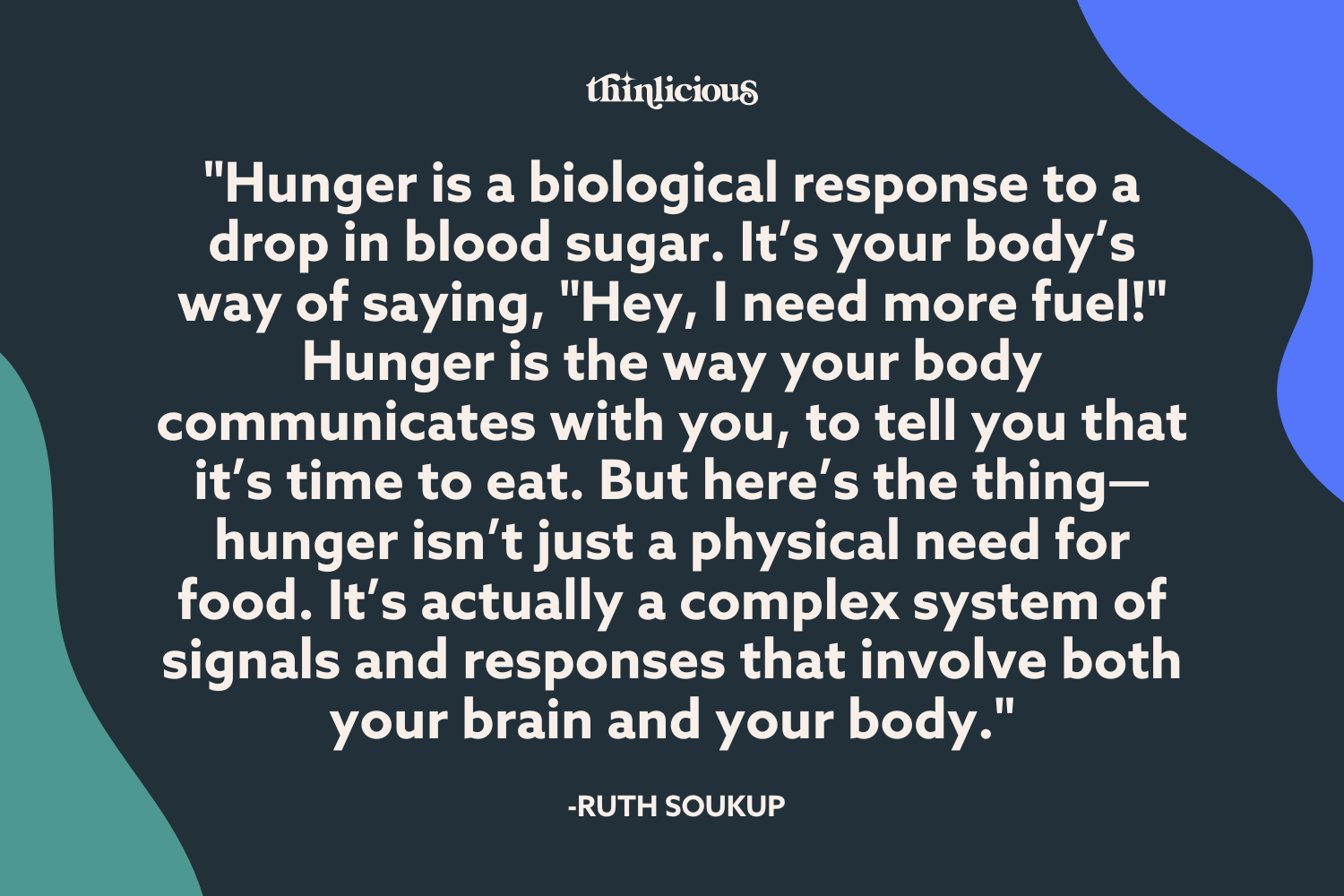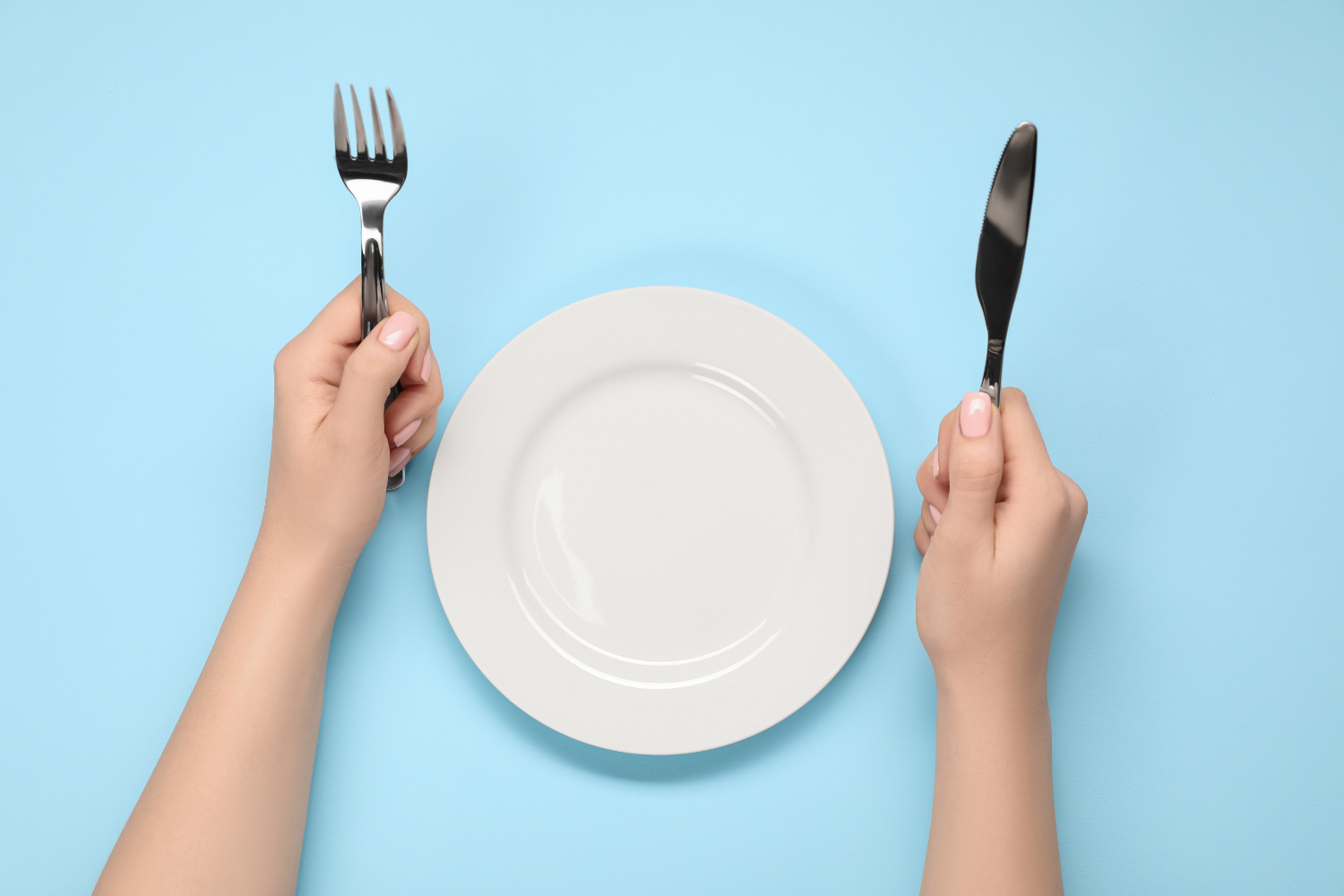[ad_1]
It never fails, right? The minute you decide you’re going to start eating better or trying to lose weight, you find yourself thinking about food ALL THE TIME.
But have you ever stopped to think about what’s ACTUALLY going on to make you feel so hungry?
Because, believe it or not, all hunger is not created equal. And if you’re ready to get serious about changing your habits, then it’s important to understand what’s actually going on, so that you can also better understand how to respond.
Because the truth is, everything we think we know about hunger is 100% WRONG.
Are you ready to create the ultimate 12-month blueprint for reaching your health & weight loss goals this coming year?

Our free on-demand video training will walk you through how to make 2024 THE year you set health goals…and keep them.
And not only that, but this misunderstanding about what hunger actually is and what it means, is one of the biggest reasons that so many of us struggle to lose weight and get healthy.
Because think about it—when you get hungry, what do you do? What’s your first instinct? If you’re anything like me, and anything like most people, your first instinct is to reach for the closest, most convenient source of food, right?
And usually that closest, most convenient source of food isn’t exactly what you might call healthy. In fact, for most of us, it’s generally some kind of unhealthy snack—chips or cookies or crackers—or maybe a sugary candy bar or soda, or even a trip to the fast food drive through.
And it’s not because we’re weak or we don’t have enough willpower or anything like that. It’s simply because we don’t really understand what hunger actually is, and we don’t know how to identify the different types of hunger that we might be feeling.
No one’s ever taught us that, right? It’s not something they teach in schools, and it’s not really something that ever gets talked about.
But honestly, understanding hunger is probably one of the very most important things you can do when it comes to changing the way you eat and getting healthy.
So let’s start at the beginning—what is hunger?

What is hunger?
Well, on the surface, it seems like a pretty simple question. Hunger is that feeling you get when you need to eat, right? It’s that gnawing, empty feeling in the pit of your stomach that just won’t quit, that has you dreaming of a big juicy cheeseburger or a giant plate of spaghetti and meatballs.
And I think that for most of us, that’s the way we’ve always thought about hunger. It’s why, when we feel that way, we immediately think to ourselves, “I need to eat something!” It’s why we get panicky and desperate for something to fill that empty space inside of us.
But the truth is, that’s not really what hunger is. That gnawing, empty feeling in the pit of your stomach is actually just one of the many symptoms of hunger. It’s a physical reaction, a signal, that your body sends to let you know that you need to eat something. But that’s all it is—a signal.
And the problem is, we’ve become so conditioned to respond to that signal, so conditioned to think of hunger as simply a physical need for food, that we don’t really pay attention to anything else. We don’t take the time to think about what our bodies might actually be trying to tell us. We don’t stop and ask ourselves, “What kind of hunger is this? Is it physical hunger? Or is it something else?”
And as a result, we often find ourselves giving in to that physical hunger, and making choices that aren’t always the best for our health.
So if hunger isn’t just a physical need for food, then what is it?
Well, to put it simply, hunger is a biological response to a drop in blood sugar. It’s your body’s way of saying, “Hey, I need more fuel!” Hunger is the way your body communicates with you, to tell you that it’s time to eat.
But here’s the thing—hunger isn’t just a physical need for food. It’s actually a complex system of signals and responses that involve both your brain and your body. And it’s not just one thing. In fact, there are actually several different types of hunger, each with it’s own unique set of symptoms and signals.

The 7 Different Types of Hunger
So, if hunger isn’t just a physical need for food, then what are the other types of hunger you should be aware of? What other signals might your body be sending, that you don’t even realize?
Type 1: Physical Hunger
The first and probably most obvious type of hunger is what I like to call physical hunger. This is the hunger that we’re all most familiar with—that gnawing, empty feeling in the pit of your stomach that just won’t quit. It’s that feeling you get when you haven’t eaten in awhile, and it feels like your stomach is literally eating itself.
But physical hunger is more than just a stomach ache. It’s a full body experience, with a whole set of symptoms that go along with it. You might feel light-headed or dizzy, or have trouble focusing or thinking clearly. You might also feel weak or shaky, or have a headache. And of course, you’ll probably feel that gnawing empty feeling in your stomach, like you could eat an entire cow.
And that’s because when you’re experiencing physical hunger, your body is telling you that your blood sugar is low and you need more fuel. It’s a biological response to a drop in blood sugar, and it’s your body’s way of saying, “Hey, I need more food!”
This is the type of hunger that it’s not necessarily a good idea to completely ignore, but it is the type of hunger that can be addressed in the most healthy way possible if you are eating a low-carb, high-fat diet. That’s because if you’re eating the right foods—meaning foods that are high in healthy fats and nutrient dense protein, and low in carbohydrates—then your body will have plenty of fat stores to tap into during those times when you’re experiencing true physical hunger.
In fact, this is one of the ways that your body is able to burn fat and lose weight more effectively when you’re eating a healthy, low-carb diet. When your body doesn’t have any carbohydrates to use for energy, it will automatically turn to your fat stores and start burning fat for fuel instead. And that’s a good thing!
Type 2: Nutritional Hunger
And that brings us to the second type of hunger—what I like to call nutritional hunger. This is the hunger that we experience when our bodies are lacking in essential nutrients, like vitamins and minerals. It’s that feeling that no matter how much you eat, it’s never enough. It’s the constant craving for more food, even when you just ate an hour ago.
And we’ve all experienced this type of hunger before. It’s the hunger that has us reaching for that bag of chips or that pint of ice cream, even after we’ve already eaten a huge meal. We think to ourselves, “I just can’t stop eating!” But the reality is, it’s not that we CAN’T stop eating, it’s that our bodies are telling us that we need more nutrients.
Because the truth is, when our bodies aren’t getting the right nutrients, we feel hungry. And we keep eating, not because we’re actually physically hungry, but because our bodies are trying to tell us that we need more of those essential vitamins and minerals.
So how do you know if you’re experiencing nutritional hunger? Well, there are a few key things to look for. First, you’ll notice that you’re constantly craving more food, even when you just ate. Second, you’ll probably feel sluggish and tired, even after a good night’s sleep.
And finally, you might also notice that you’re experiencing other symptoms of nutrient deficiency, like hair loss, brittle nails, or dry skin.
Nutritional hunger is definitely something to worry about, because if your body isn’t getting the right stuff, your whole body will suffer and you just won’t feel good.
That’s why the best way to overcome nutritional hunger is to focus on making sure you’re getting the right nutrients from the right foods, in a way that tastes good to you. That means choosing foods that are high in healthy fats and nutrient-dense protein and low in carbohydrates, but that are also as fresh and unprocessed as possible. It means making sure you’re getting lots of variety in your diet and not eating the same thing every day. It means finding recipes that you really enjoy, and that have lots of flavor, but without all the added sugar and processed junk.
Type 3: Emotional Hunger
And that brings us to the third type of hunger—what I like to call emotional hunger. This is the hunger that we experience when we’re feeling stressed, or lonely, or bored. It’s that feeling of needing something to fill the void, even when our bodies aren’t actually hungry.
And we’ve all experienced this type of hunger before, too. It’s the hunger that has us reaching for the ice cream when we’ve had a bad day, or the bag of chips when we’re feeling lonely. It’s the hunger that has us eating an entire pizza, even when we’re not actually physically hungry.
But here’s the thing—emotional hunger is not the same as physical hunger. It’s not a biological response to a drop in blood sugar, but rather a psychological response to our emotions. And that means that no amount of food will ever actually satisfy our emotional hunger.
So how do you know if you’re experiencing emotional hunger?
Well, there are a few key things to look for. First, you’ll notice that you’re eating even when you’re not physically hungry. Second, you might notice that you’re craving specific types of food, like ice cream or chips, that you associate with comfort. And finally, you’ll probably also notice that you’re experiencing other symptoms of emotional distress, like stress or anxiety.
But the key to identifying emotional hunger is to become more aware of your feelings and your triggers. You need to ask yourself “am I actually hungry, or am I trying to fill some other need?”
And if you find that you are dealing with emotional hunger, then the best thing you can do is to find healthier ways to cope with your emotions that don’t involve food. And there’s a lot more I could say about just this topic, but I’ve actually written a whole post JUST on emotional eating, so if you haven’t listened to that one yet and this is an issue for you, you might want to go back and check that one out.
But the more you can find non-food-related ways to soothe yourself and deal with your emotions, the better off you’ll be. Because the truth is that food, while it might make you feel better in the moment, won’t actually solve anything, and it will just lead to more weight gain and more feelings of guilt and shame.
Type 4: Habitual Hunger
And that brings us to the fourth type of hunger—what I like to call habitual hunger. This is the hunger that we experience out of habit, rather than actual physical need. It’s that feeling of needing to eat at a specific time, even when our bodies aren’t actually hungry.
And we’ve all experienced this type of hunger before, too. It’s the hunger that has us reaching for a snack at 3pm every day, even when we just ate lunch. It’s the hunger that has us eating a big bowl of pasta before bed, because that’s what we’ve always done.
But here’s the thing—habitual hunger is not the same as physical hunger. It’s not a biological response to a drop in blood sugar, but rather a psychological response to our habits and routines. And that means that no amount of food will ever actually satisfy our habitual hunger.
So how do you know if you’re experiencing habitual hunger?
Well, there are a few key things to look for. First, you’ll notice that you’re eating at the same times every day, even when you’re not physically hungry. Second, you might notice that you’re craving specific types of food, like a mid-morning snack or a late-night snack, that you associate with certain times of day. And finally, you’ll probably also notice that you’re experiencing other symptoms of hunger, like a rumbling stomach or light-headedness, even when you know you shouldn’t be hungry.
But the good news is that habitual hunger is also the easiest type of hunger to overcome, simply by changing your habits and your routine. If you can get in the habit of doing something else at that time—whether it’s taking a walk, or doing a quick workout, or just drinking a cup of herbal tea, or even just finding a new way to relax or reward yourself—then you’ll find that this type of hunger will quickly go away.
And if you’re trying to lose weight, then this is definitely the type of hunger that you want to focus on overcoming, because it can be a big roadblock to your success. So be aware of your habits and your routine, and try to find ways to change them if you’re struggling with this type of hunger.
Type 5: Environmental Hunger
The fifth type of hunger that we often experience is what I like to call environmental hunger. This is the type of hunger that is triggered by your environment—whether that’s the smell of fresh-baked cookies, or the sight of a candy dish on your co-worker’s desk, or the sound of someone crunching on a bag of chips.
Environmental hunger can also be triggered by a specific location or situation—like going to a party, or to a movie theater, or to a sporting event. It’s the type of hunger that happens when you’re not even thinking about food, but then you see it or smell it and suddenly you can’t get it out of your head.
And the thing about environmental hunger is that it can be really, really hard to resist, because it often feels so overpowering. But that also means that usually the best way to overcome environmental hunger is simply to remove yourself from the environment that’s triggering it.
If you’re at work and someone has a candy dish on their desk that’s constantly calling your name, then try moving your desk, or take a different route so you don’t have to walk past it. If you’re at a party or a social event and you’re feeling triggered, then go outside for a little bit of fresh air, or find a different room to hang out in. If you find yourself constantly tempted by the smell of fresh-baked cookies, then try closing your door or turning on a fan.
And if none of that is possible, then just try distracting yourself for a few minutes until the craving passes. Sometimes all it takes is a momentary distraction to help you refocus and move on.
Type 6: Thirst
The sixth type of hunger that we often experience is actually not hunger at all—it’s thirst. That’s right—sometimes when we think we’re hungry, we’re actually just thirsty. And while you might think that would be an easy thing to distinguish, the truth is that the symptoms can be very similar—you might feel a little weak or lightheaded, and your stomach might be growling.
So that’s why the best thing you can do if you’re trying to determine whether you’re actually hungry or just thirsty is to start by drinking a glass of water. If the feeling goes away, then you were just thirsty. If not, then you know it’s true physical hunger.
And honestly, even if you do find that you’re truly physically hungry, it’s still a good idea to make sure you’re staying well-hydrated, because that can help your body function better and make it easier to lose weight in the long run.
Type 7: Addictive Hunger & True Cravings
And that brings us to the final type of hunger—what I like to call addictive hunger, or true CRAVINGS. This is the hunger that we experience when our bodies are craving something that we’re addicted to, like sugar or carbohydrates. It’s that feeling of needing to eat more and more of those foods, even when our bodies aren’t actually hungry.
And I think this is probably the most dangerous type of hunger, because it’s the hunger that we have the hardest time controlling. We think to ourselves, “I’ll just have one cookie,” and the next thing you know, you’ve eaten the entire box.
But here’s the thing—addictive hunger is not the same as physical hunger. It’s not a biological response to a drop in blood sugar, but rather a chemical response to our addictions. And that means that no amount of food will ever actually satisfy our addictive hunger.
So how do you know if you’re experiencing addictive hunger? Well, there are a few key things to look for. First, you’ll notice that you’re craving specific types of food, like cookies or bread, that you associate with your addictions. Second, you might notice that you’re eating more and more of those foods, even when you’re not physically hungry. And finally, you’ll probably also notice that you’re experiencing other symptoms of addiction, like withdrawal or cravings.
But the good news is that there are actually a few really great ways to overcome addictive hunger and true cravings, if you’re willing to try them.
The first strategy is to simply wait it out. True cravings are often triggered by your hormones, and they usually only last about 15 minutes. So if you can find a way to distract yourself for just a little bit of time, then the craving will often pass on its own.
The second strategy is to try eating a small piece of something that tastes very differently from the food you’re craving. So if you’re craving something sweet, try eating a small piece of cheese. If you’re craving something salty, have a tiny bite of dark chocolate. This can often help to satisfy the craving without derailing your progress.
The third strategy is to practice what I like to call “planned indulgence.” This is where you allow yourself to have a small, portion-controlled version of the food you’re craving, but only if it’s a food that you absolutely love and that’s truly worth it to you. This can be a great strategy for when you’re craving something that’s not necessarily unhealthy, but that might be higher in carbs or calories than you’d like to eat on a regular basis. So for me, this might mean that if I’m really, really craving a piece of dark chocolate with sea salt, I’ll allow myself to have just one, but only if it’s the good stuff—like at least 70% dark chocolate.
And then the final strategy for dealing with true cravings is to simply practice moderation. Because the truth is that you don’t have to completely eliminate all the foods you love from your life forever—you just have to find a way to enjoy them in a way that doesn’t completely derail your progress.

Final Thoughts
So now that you know what the 7 different types of hunger are, how do you actually recognize them? And how do you know if you’re experiencing one type of hunger, or a combination of several different types? And more importantly, what can you actually DO about it?
Well, the answer is actually pretty simple—pay attention to your body. Listen to what it’s trying to tell you. And be mindful of the different symptoms and signals that you might be experiencing.
For example, if you’re feeling that gnawing, empty feeling in the pit of your stomach, that’s a pretty good sign that you’re experiencing physical hunger. But if you notice that you’re also feeling light-headed or dizzy, that’s a good sign that you might be experiencing nutritional hunger as well.
Or if you find yourself reaching for that bag of chips, even when you’re not physically hungry, that’s a pretty good sign that you might be experiencing emotional hunger. But if you notice that you’re also feeling stressed or anxious, that’s a good sign that you might be experiencing addictive hunger as well.
But here’s what I’ll tell you from my own experience:
The BEST way to actually overcome these different types of hunger is to EAT.
To stop depriving yourself and falling into the trap of thinking that if you want to lose weight and get healthy, you’ve got to restrict your calories or cut back on the quantity of food you’re eating.
It’s always going to be a recipe for disaster.
The truth is that as long as you’re eating the RIGHT foods, the healthy fats and nutrient-dense proteins and whole foods that are low in sugar and carbohydrates and free of all that processed junk that is literally designed to make us crave it more, you can basically eat as MUCH as you want!
Because, like I said at the beginning, healthy weight loss really has NOTHING to do with calories, and EVERYTHING to do with hormones.
When your body is getting what it needs, and your hormones are able to stabilize, it triggers your body to release fat.
Now does that mean you won’t still struggle with emotional eating or with breaking those long established habits, or being tempted by that pan of fresh-baked cookies that smell so good?
Of course not, there will still be moments. But if you’re eating the right way and allowing yourself to eat PLENTY of really good food, those moments will be the exception, not the rule.
And that’s a big deal.
So if you’re ready to get started with this new way of eating, be sure to check out our free training—it’s called Health, Happy & Free, and it will walk you through our process and everything you need to understand to make your own personalized health plan for the next 12 months.
[ad_2]
Source link



